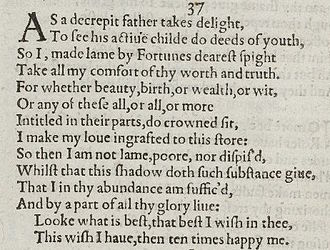Sonnet 37
| Sonnet 37 | |||||||
|---|---|---|---|---|---|---|---|
 Sonnet 37 in the 1609 Quarto | |||||||
| |||||||
Just as an aged father takes delight in the youthful actions of his son, so I, crippled by fortune, take comfort in your worth and faithfulness. For whether it's beauty, noble birth, wealth, or intelligence, or all of these, or all of these and more, that you possess, I attach my love to it (whatever it is), and as a result I am no longer poor, crippled, or despised. Your mere shadow (present in me) provides such solid reality to me that I am complete with it. I wish whatever is best in you, and if this wish is granted, then I will be extremely happy.
Structure
Sonnet 37 is an English or Shakespearean sonnet. The English sonnet is constructed with three quatrains and a final rhyming couplet. The poem follows the form's typical rhyme scheme, ABAB CDCD EFEF GG, and like other Shakespearean sonnets is written in iambic pentameter, a type of poetic metre based on five pairs of metrically weak/strong syllabic positions per line. The second line exemplifies a regular iambic pentameter:
× / × / × / × / × / To see his active child do deeds of youth, (37.2)
- / = ictus, a metrically strong syllabic position. × = nonictus.
Source and analysis
The sonnet was at one point a favorite of biographically oriented critics, such as
"Dearest" (3) is glossed by Gervinus as "heartfelt", but Malone's gloss "most operative" is generally accepted.
Line 7 has been much discussed. Malone's emendation of "their" to "thy" is no longer accepted. George Steevens, finding an analogy in The Rape of Lucrece, glosses it as "entitled (ie, ennobled) by these things." Nicolaus Delius has it "established in thy gifts, with right of possession." Sidney Lee has "ennobled in thee", reversing the relationship between beloved and "parts." It is commonly agreed that the image is drawn from heraldry.
"Shadow" and "substance" are drawn from Renaissance Neoplatonism; Stephen Booth notes that the wit of line 10 derives from Shakespeare's reversal of the usual relationship between reality and reflection.
Notes
- OCLC 4770201.
References
- Baldwin, T. W. On the Literary Genetics of Shakspeare's Sonnets. Urbana: University of Illinois Press, 1950.
- Hubler, Edwin. The Sense of Shakespeare's Sonnets. Princeton: Princeton University Press, 1952.
- First edition and facsimile
- Shakespeare, William (1609). Shake-speares Sonnets: Never Before Imprinted. London: Thomas Thorpe.
- OCLC 458829162.
- Variorum editions
- OCLC 234756.
- Modern critical editions
- Atkins, Carl D., ed. (2007). Shakespeare's Sonnets: With Three Hundred Years of Commentary. Madison: OCLC 86090499.
- OCLC 2968040.
- Burrow, Colin, ed. (2002). The Complete Sonnets and Poems. OCLC 48532938.
- OCLC 32272082.
- OCLC 15018446.
- Mowat, Barbara A.; Werstine, Paul, eds. (2006). Shakespeare's Sonnets & Poems. OCLC 64594469.
- OCLC 46683809.
- OCLC 36806589.
External links
 Works related to Sonnet 37 (Shakespeare) at Wikisource
Works related to Sonnet 37 (Shakespeare) at Wikisource- Analysis


